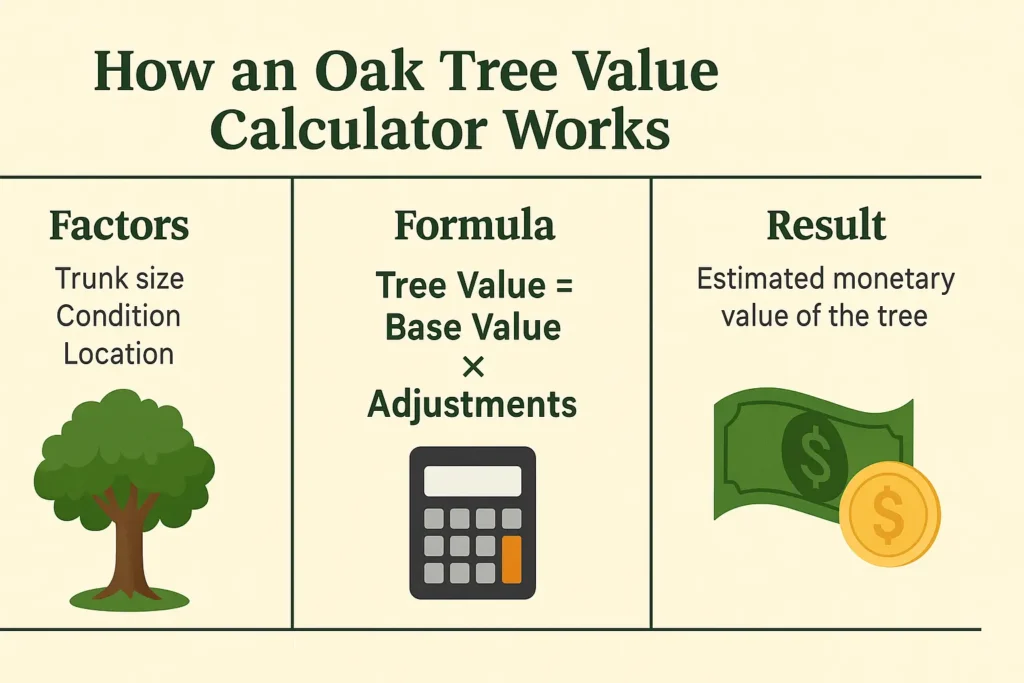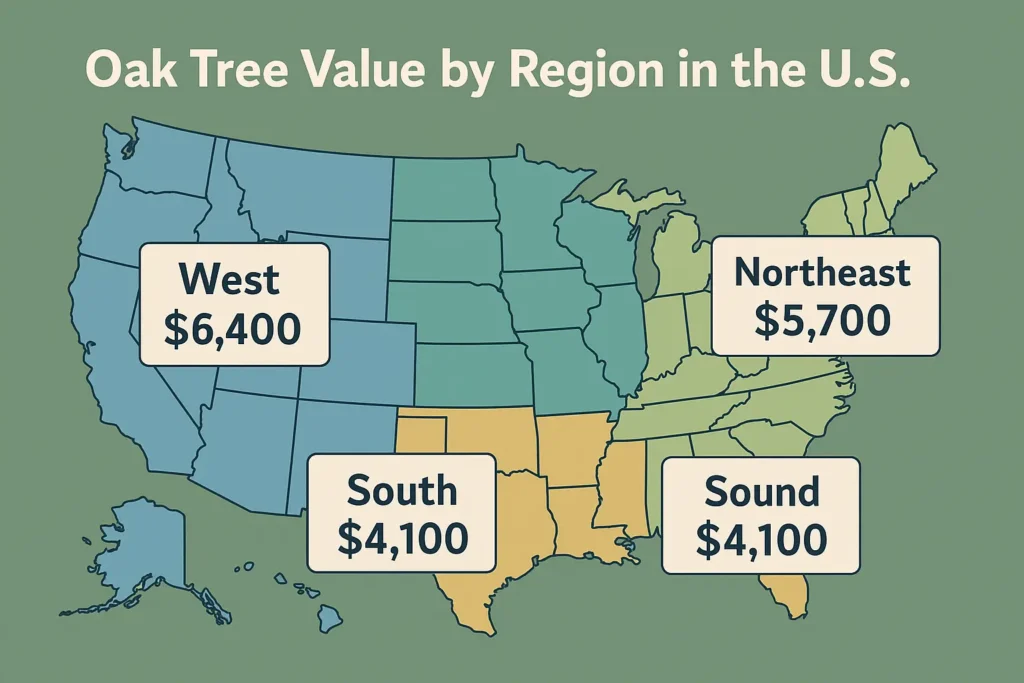Tree Condition reflects overall health, structural integrity, and vitality. A rating of 100% indicates perfect health.
Location Rating considers site quality, room to grow, and aesthetic value. A rating of 100% suggests an ideal environment.
Estimate the monetary value of your oak tree using trunk diameter, condition, location, and species.
Tree Condition reflects overall health, structural integrity, and vitality. A rating of 100% indicates perfect health.
Location Rating considers site quality, room to grow, and aesthetic value. A rating of 100% suggests an ideal environment.

With a background in botany and ecological sciences, James specializes in creating practical tools and resources to help gardeners, farmers, and plant enthusiasts optimize their green spaces.
The Oak Tree Value Calculator is a simple and effective tool to estimate the worth of your oak tree based on trunk diameter, condition, and location. Whether you are a landowner, forester, or investor, this tool provides an accurate estimate using industry-standard calculations.

If you’ve ever stood beneath a tall, mature oak and thought, this must be worth something, you’re not alone. Many homeowners turn to an oak tree value calculator to put a dollar amount on that thought—but the answer is more complicated than it seems.
The value of an oak tree depends on:
Species – White Oak, Red Oak, Bur Oak, etc.
Size – measured by DBH (Diameter at Breast Height)
Condition – health, form, and straightness
Use – timber harvesting vs. landscaping aesthetics
A well-formed, disease-free White Oak with a DBH of 30 inches might be worth several thousand dollars—if it’s in a harvestable area. That same tree in a suburban yard, surrounded by fences and power lines? Possibly worth more alive than cut.
That’s the thing—context changes everything.
White Oak is generally the most valuable oak species, prized for its strength, grain, and high demand in furniture and flooring but here are a few worth noting:
White Oak (Quercus alba) – Extremely valuable for lumber. Dense, strong, and in high demand.
Northern Red Oak (Quercus rubra) – Also valuable, especially in Eastern U.S. lumber markets. Slightly less than White Oak.
Bur Oak (Quercus macrocarpa) – Sometimes overlooked, but quite valuable in regions like the Midwest.
Live Oak (Quercus virginiana) – Less commercially valuable due to twisted grain, but iconic and valuable for landscape.
Interestingly, some people swear by the value of Black Oak—but timber buyers often consider it lower-grade due to internal checking and more frequent decay. It’s a reminder that perceived value and market value don’t always align.
Size is one of the first things any oak tree value calculator asks for. But how does size actually impact price?
Here’s a rough breakdown based on DBH (assuming healthy White Oak in a harvestable location):
$50 – $150
$200 – $800
$800 – $1,500
$1,500 – $2,500+
You can use our Tree Diameter Calculator to measure your tree accurately, then plug the number into the Oak Tree Value Calculator to get a personalized estimate.
Of course, this chart assumes ideal conditions. If your tree is leaning, forked, or diseased, values drop fast.
Enter Trunk Diameter (DBH): Input the tree’s diameter at breast height (4.5 feet above ground) in inches.
Assess Tree Condition: Assign a percentage from 0% (dead) to 100% (perfect health).
Evaluate Location Rating: Input a rating from 0% (poor placement) to 100% (ideal location).
Set Base Cost per Square Inch: A default value is provided, but it can be adjusted based on market rates.
Get the Estimated Value: The calculator will provide the estimated value of your oak tree in USD.
There are two schools of thought when it comes to oak tree value:
Lumber Value – Based on usable wood volume. Relevant if the tree can be harvested.
Landscape Value – Based on its contribution to your property’s aesthetics, shade, and ecological role.
An oak that adds $3,000 in cooling value and curb appeal might only be worth $500 in lumber. Ironically, removing it could lower your property value more than you’d gain from the wood.
Landscape appraisals often follow CTLA (Council of Tree and Landscape Appraisers) methods—factoring species, size, location, and condition. You can explore this approach in our Tree Value Calculator, which considers both timber and ornamental factors.
The calculator estimates the tree’s worth using the following formula:
Estimated Value = (π × (DBH²) / 4) × Base Cost × (Condition % / 100) × (Location % / 100)
This formula considers the cross-sectional area of the tree, adjusts for health and location, and applies a base cost per square inch.
Not every big tree is valuable. These are signs that your oak might be worth real money:
Straight Trunk – A single, unbranched trunk adds value.
Good Form – Minimal twist, no low branches or major forks.
Healthy Crown – A full canopy suggests vitality and strong wood.
No Visible Rot – Even small hollow sections reduce usable volume.
Desirable Species – As mentioned, White and Northern Red Oaks rank highest.
Some arborists say, if you can see daylight through the trunk, subtract a zero from your estimate. Dramatic, yes, but not entirely inaccurate.

Professionals often use the CTLA formula, which considers:
Species rating (some trees are more desirable)
Trunk size (usually DBH)
Tree condition (deadwood, disease, form)
Location adjustment (urban, rural, utility proximity)
Certified arborists may also refer to local timber prices and apply a board foot calculation, especially for high-value oaks.
While a calculator gives you a starting point, a certified appraisal is still the most accurate route for insurance claims or property assessments.
Technically, yes—but legally and practically, it’s not always simple.
In rural areas, timber buyers often scout for valuable oaks, especially if there’s more than one on the property. But in residential zones, zoning laws, access issues, and permits often get in the way.
In some states, like California or New York, oaks may be protected species. Removal could require a permit, even if the tree is on your land.
It’s worth checking with local forestry agencies or municipal guidelines before attempting to sell or remove.
If you’re trying to estimate the value of an oak, age helps—but you don’t need to cut the tree down to find it.
Most experts use DBH and apply a species-specific growth factor. For example:
White Oak: Multiply DBH by 5.0
Red Oak: Multiply DBH by 4.0
So, an 18-inch White Oak might be around 90 years old. You can skip the math using our Tree Age Calculator, which estimates age instantly based on size and species.
Keep in mind, though, age doesn’t guarantee value. A 100-year-old tree with rot may be worth less than a 50-year-old tree in perfect condition.
Let’s say your tree is valued at $1,200. That’s great—unless it costs $1,500 to remove.
In urban settings, tree removal costs can outweigh tree value, especially if cranes, traffic rerouting, or stump grinding are involved. You can estimate removal prices with our Tree Removal Cost Calculator or fallen tree removal cost calculator.
Sometimes, leaving the tree where it stands is the most financially sound option.

Finally, a quick word on oak lumber markets. Prices are highly regional and seasonal.
Some of the biggest price influencers include:
Species – White Oak consistently fetches the highest price.
Moisture Content – Kiln-dried lumber sells for more.
Board Foot Volume – Larger logs = lower price per unit due to efficiency.
Market Demand – Housing booms increase demand for flooring and furniture-grade wood.
Regional Competition – If your area has several timber suppliers, prices may be lower.
Lumber prices can range from $1.50 to over $10 per board foot, depending on the factors above.
What is an oak tree worth?
An oak tree’s value can range from $100 to several thousand dollars, depending on its species (e.g., white oak vs. red oak), size, age, health, and market demand. A mature, healthy oak with high-quality timber and good access can be particularly valuable. That said, ornamental value in landscaping or ecological benefit can often exceed its timber price.
How to calculate the cost of a tree?
Tree cost or value is typically estimated using a formula based on trunk diameter (or circumference), total height, and a species-specific multiplier. In timber value calculations, volume in board feet is used, multiplied by the market rate per board foot. For yard or landscaping trees, location, aesthetics, and shade value might also factor in.
How to calculate the age of an oak tree?
You can estimate the age of an oak tree by measuring the trunk’s diameter and multiplying by a species-specific growth factor. For white oak, for example, multiply the diameter (in inches) by roughly 5.0 to 5.5. A Tree Age Calculator offers a more precise estimate, especially when you’re unsure of the growth rate for your specific region or species.
What is the value of oak wood?
Oak is prized for its strength, grain, and durability. In timber markets, oak logs can sell for $200 to $600 per thousand board feet, though veneer-grade logs can fetch significantly more. The value depends heavily on straightness, lack of knots, and consistent growth rings.
What is the current price of oak?
Prices vary by region and market conditions. As of now, sawmill-grade oak typically sells for $0.50 to $1.20 per board foot, while veneer oak can exceed $3.00 per board foot. Always check with local mills or forestry reports for the most accurate rates.
Why is oak so valuable?
Oak is valued for its hardness, resistance to rot, aesthetic grain pattern, and long lifespan. It’s a top choice for furniture, flooring, wine barrels, and high-end architectural uses. In ecological terms, oak trees also support a wide range of wildlife, making them valuable beyond the lumber yard.
How much is a 100-year-old oak tree worth?
A 100-year-old oak tree could be worth $1,000 to over $10,000, depending on its condition, species, trunk quality, and location. While that’s the upper end, many oaks of this age have a high sentimental or landscape value, which may not always translate directly to timber pricing.
How many leaves are on a 100-year-old oak tree?
It’s estimated that a mature oak tree can carry anywhere from 200,000 to 500,000 leaves during peak foliage season. The exact number depends on the tree’s health, canopy spread, and species. For a fun and surprisingly accurate estimate, try our Tree Leaves Calculator, which helps visualize leaf count based on tree dimensions.
This calculator provides estimates based on industry formulas and market values. For official appraisals, consult a professional arborist or forestry expert.
Try the Oak Tree Value Calculator today and determine the potential value of your trees!
Discover Tree & Forestry Calculators
